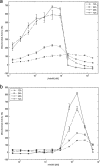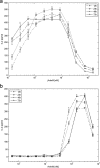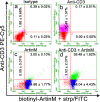Activation of spleen cells by ArtinM may account for its immunomodulatory properties
- PMID: 24842046
- PMCID: PMC4148593
- DOI: 10.1007/s00441-014-1879-8
Activation of spleen cells by ArtinM may account for its immunomodulatory properties
Abstract
ArtinM is a D-mannose-binding lectin extracted from Artocarpus heterophyllus that promotes interleukin-12 production by macrophages and dendritic cells. This property is considered responsible for T helper 1 immunity induced in vivo after ArtinM administration. In this study, we investigated the effect of native (jArtinM) and recombinant (rArtinM) forms of lectin on murine spleen cells and isolated T lymphocytes. We found that ArtinM binds to the surface of spleen cells. This interaction, which was blocked by D-mannose, induced cell activation, as manifested by increased mitochondrial activity, interleukin-2 production, and cell proliferation. We verified that a 30-times higher concentration of rArtinM was required to trigger optimal activation of spleen cells compared with that needed with jArtinM, although these proteins have identical sugar recognition properties and use the same signaling molecules to trigger cell activation. Because the distinction between native and recombinant is restricted to their tertiary structure (tetrameric and monomeric, respectively), we postulated that the multi-valence of jArtinM accounts for its superiority in promoting clustering of cell surface glycoreceptors and activation. The jArtinM and rArtinM activation effect exerted on spleen cells was reproduced on purified CD4(+) T cells. Our results suggest that ArtinM interaction with T cells leads to responses that may act in concert with the interleukin-12 produced by antigen-presenting cells to modulate immunity toward the T helper 1 axis. Further studies are necessary to dissect ArtinM/T-cell interactions to more fully understand the immunomodulation induced by carbohydrate recognition.
Figures










Similar articles
-
ArtinM: Purification and Evaluation of Biological Activities.Methods Mol Biol. 2020;2132:349-358. doi: 10.1007/978-1-0716-0430-4_34. Methods Mol Biol. 2020. PMID: 32306342
-
ArtinM Mediates Murine T Cell Activation and Induces Cell Death in Jurkat Human Leukemic T Cells.Int J Mol Sci. 2017 Jun 30;18(7):1400. doi: 10.3390/ijms18071400. Int J Mol Sci. 2017. PMID: 28665310 Free PMC article.
-
Characterization and optimization of ArtinM lectin expression in Escherichia coli.BMC Biotechnol. 2012 Aug 2;12:44. doi: 10.1186/1472-6750-12-44. BMC Biotechnol. 2012. PMID: 22857259 Free PMC article.
-
The immunomodulatory effect of plant lectins: a review with emphasis on ArtinM properties.Glycoconj J. 2013 Oct;30(7):641-57. doi: 10.1007/s10719-012-9464-4. Epub 2013 Jan 9. Glycoconj J. 2013. PMID: 23299509 Free PMC article. Review.
-
Lectins as mitosis stimulating factors: Briefly reviewed.Life Sci. 2018 Aug 15;207:152-157. doi: 10.1016/j.lfs.2018.06.003. Epub 2018 Jun 5. Life Sci. 2018. PMID: 29879403 Review.
Cited by
-
Frutapin, a lectin from Artocarpus incisa (breadfruit): cloning, expression and molecular insights.Biosci Rep. 2017 Jul 21;37(4):BSR20170969. doi: 10.1042/BSR20170969. Print 2017 Aug 31. Biosci Rep. 2017. PMID: 28684550 Free PMC article.
-
Effect of ArtinM on Human Blood Cells During Infection With Paracoccidioides brasiliensis.Front Microbiol. 2018 May 4;9:867. doi: 10.3389/fmicb.2018.00867. eCollection 2018. Front Microbiol. 2018. PMID: 29780375 Free PMC article.
-
ArtinM Cytotoxicity in B Cells Derived from Non-Hodgkin's Lymphoma Depends on Syk and Src Family Kinases.Int J Mol Sci. 2023 Jan 5;24(2):1075. doi: 10.3390/ijms24021075. Int J Mol Sci. 2023. PMID: 36674590 Free PMC article.
-
Therapeutic administration of recombinant Paracoccin confers protection against paracoccidioides brasiliensis infection: involvement of TLRs.PLoS Negl Trop Dis. 2014 Dec 4;8(12):e3317. doi: 10.1371/journal.pntd.0003317. eCollection 2014 Dec. PLoS Negl Trop Dis. 2014. PMID: 25474158 Free PMC article.
-
Adjuvant ArtinM favored the host immunity against Cryptococcus gattii infection in C57BL/6 mice.Immunotherapy. 2024;16(11):733-748. doi: 10.1080/1750743X.2024.2360384. Epub 2024 Jun 28. Immunotherapy. 2024. PMID: 38940276 Free PMC article.
References
-
- Benoist H, Culerrier R, Poiroux G, Segui B, Jauneau A, Van Damme EJ, Peumans WJ, Barre A, Rouge P. Two structurally identical mannose-specific jacalin-related lectins display different effects on human T lymphocyte activation and cell death. J Leukoc Biol. 2009;86:103–114. doi: 10.1189/jlb.0708434. - DOI - PubMed
-
- Cardoso MR, Mota CM, Ribeiro DP, Santiago FM, Carvalho JV, Araujo EC, Silva NM, Mineo TW, Roque-Barreira MC, Mineo JR, Silva DA (2011) ArtinM, a D-mannose-binding lectin from Artocarpus integrifolia, plays a potent adjuvant and immuno stimulatory role in immunization against Neospora caninum. Vaccine 29:9183–9193 - PubMed
-
- Coltri KC, Oliveira LL, Pinzan CF, Vendruscolo PE, Martinez R, Goldman MH, Panunto-Castelo A, Roque-Barreira MC. Therapeutic administration of KM + lectin protects mice against Paracoccidioides brasiliensis infection via interleukin-12 production in a toll-like receptor 2-dependent mechanism. Am J Pathol. 2008;173:423–432. doi: 10.2353/ajpath.2008.080126. - DOI - PMC - PubMed
-
- Coltri KC, Oliveira LL, Ruas LP, Vendruscolo PE, Goldman MH, Panunto-Castelo A, Roque-Barreira MC. Protection against Paracoccidioides brasiliensis infection conferred by the prophylactic administration of native and recombinant ArtinM. Med Mycol. 2010;48:792–799. doi: 10.3109/13693780903501671. - DOI - PubMed
Publication types
MeSH terms
Substances
LinkOut - more resources
Full Text Sources
Other Literature Sources
Research Materials

